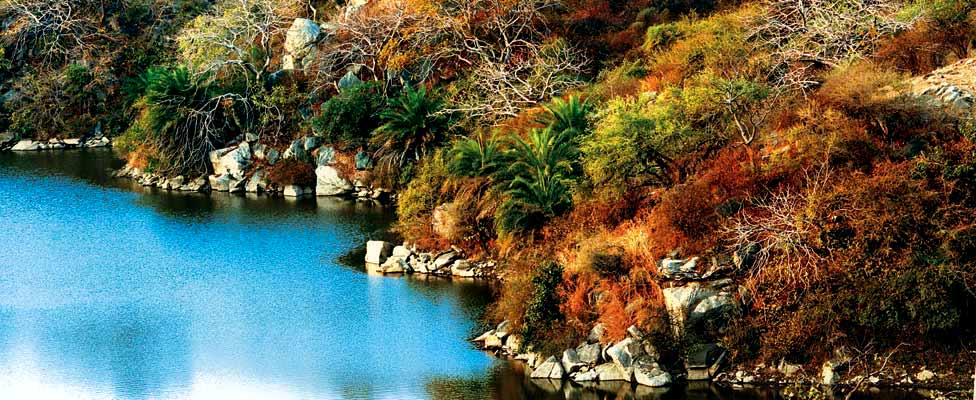
Regrowing a forest, one tree at a time, in a remote Mewar village
It’s an oxymoron. Luxury quarters, actually a converted former hunting outpost, set in a private forest where you can stay and, well, be the only human around for as far as you can see in any direction. For company, there’s nilgai, leopards, jackals, langurs, an extensive range of feathered soon-to-be friends, topped by a sweep of stars twinkling more brightly than you’ve ever seen them. Sitting at night in the middle of this melodious, breezy silence in the just opened Shikhar Odi of Kemri Nature Reserve, approximately 44 kilometres southeast of Udaipur, one can be reflective and philosophical. Or feel just plain blessed to be able to revel in such stunning beauty, deep inside a forest.

It has not been an easy journey. Mayur Singh will be the first to admit that the forest cover cannot be revived to its former level. It will not be for lack of trying though. This former HSBC VP, along with wife Bhawna Singh, has taken on the ambitious goal of reviving a forest in about 400 acres of rural Mewar. Acres of scrub are being revived by planting trees–each year about 800 new trees are planted. Volunteers, including students from Udaipur, do the planting, along with paid labour. “We plant trees with care to ensure their survival,” stresses Mayur Singh, contrasting his efforts to the sorry state of government tracts. Tourists are welcome, indeed urged, to join in the planting. For those with a ken for responsible rural tourism, this is ground zero.
The Singhs started this project about five years ago, on land that is cooperatively owned. While an overall uplift of the area through the education of girls and community-based projects is also part of the agenda, Kemri Nature Reserve is reviving a forest and hoping to attract tourists through select lodgings.
It may be hard to believe, but once upon a time, and not so long ago, almost all of Mewar, along the Aravalis from Abu to Delhi, was covered in forest where big cats ruled. Mewar, once a region thriving on a traditional forest-based economy, lost almost all forest cover in the years following Independence. The Indian state had more pressing problems than forest conservation, and the erstwhile ruling princes could no longer enforce policy, resulting in mass and rapid felling of trees.

The evidence for the once dense forest cover lies in the number of shikhargahs for hunting–found even in the middle of Delhi. Most of these areas were once part of former ‘princely’ states. Whatever their other merits or lack thereof, the princes protected forests as they wanted to hunt in them. While they gave out agricultural land to their subjects, the ruling clans were very interested in hunts and had to maintain forests for them. A situation that continued in Mewar for the last few decades, again till post independence as families migrated in search of better economic opportunities, resulting in the loss of traditional safeguards for nature. It is only of late that private individuals are taking up what seemed like a lost cause.
Today, even a basic look at land in the area shows the loss of green cover and the resultant disappearing of fauna. Just patches of ‘forest’ remain–almost all under government. Denuded scrubland that even grazing herds ignore would be closer to the truth. Bhawna Singh, who came here after her marriage to Mayur in 1994, remembers the area then as sparse and deserted.
1964-born Mayur has roots here. His ancestor, Maha Singh, was awarded the jagir of Batheda in 1711 for valour in battle, and the family administered the land till 1947. Even though he never stayed here, Mayur visited frequently, has friends in the village and speaks the local dialect. Despite a lengthy stint in banking, the family seat beckoned, and he began taking six months off work annually to stay at Batheda a few years ago and then finally left to work full time here. “I always wanted to do something that was outdoorsy, and this area is very compelling in terms of its geography, making me look at conservation and reforestation,” says Mayur.

The increase in green cover over just five years is remarkable. As I stumble through the stony valley, Mayur points out the finer details of this deciduous forest. Its endemic species include dhavdi or dhok (Anogeissus pendula), flame of the forest (Butea monosperma) and gondhal (Lannea coromandelica). The Singhs have also planted local trees such as cassia, banyan, desi mango, mahua, karanj, date, shisham, arjun, bamboo, imli, jamun and more among the 6,000 planted already. In a separate protected enclosure, they are experimenting with about 300 tree species.
The results are already visible, though not all the trees have grown to their full potential yet. The diversity of trees ensures a greater variety of animal species, points out Mayur. Yes, you can sit out in the middle of this forest–in your room–and witness a nilgai quenching her thirst or a langur family out for an evening stroll. With warning from monkeys, and considerable luck, you might even spot a leopard. Ask the Singhs for photographic evidence of three leopards playing around their Scorpio one night. A night drive through the forest yields more sightings, from nilgai to rabbits and even cobras and pythons.
There is a binocular handy for birders, and the chirping-swooshing-chasing and snacking by the birds could keep you enthralled all day. Migratory birds such as bar headed geese, demoiselle cranes, pintail ducks, northern shovellers, pelicans, flamingoes, cormorants, raptors and ibises are the stars of the winter season, while residents include whistling teals, spotbills and comb ducks. Mayur says there are about 150 species on show, and this could well be a birding destination soon.

Till now, guests have only stayed at the Rawla Batheda, the ancestral haveli, which is just outside the forest limits. It used to be the administrative centre of the region, with its own office, court and even a jail, where at its peak more than 100 people worked. A sprawling L-shaped structure, it is typical of havelis in the region, with additions over time, so it is difficult to say how many levels it has. Run-down in parts, other sections have been spruced up to accommodate guests. Old style rooms, steep staircases, stone ceilings, thick walls interspersed by jaalis, an occasional chhatri or corners, ornate diyas livening up the interiors, bearers serving traditional meals–it is a throwback to life in another era. Yes, you could still opt to stay here, and Ganpat Singh, the resident majordomo, will look after you very well.
Shikhar Odi, inside the forest, is the first of the two modern residential units launched for tourists. A further eight rooms, whose interiors remain to be done, are slated to open later, identical in design, and just across a lake. Every care has been taken to keep their carbon footprint to a minimum, from solar panels for heating to use of local stone for roofing and cladding and doing away with sachets for tea and coffee, instead storing them in jars. Though there is no TV, Mayur’s interest in birds ensures multiple coffee table books are helpfully strewn around. Insulation is through inverted pots. Mayur points out that except for the AC, the rest of the property can function on just 350 volts. Installing an AC was much debated, reveals Bhawna, but they figured Rajasthan’s summer heat would be unbearable for guests without one.

Aesthetically done up, the rooms are named after the peacock and the jungle fowl, themes that extend to the colour schemes within. Each room has an overhanging balcony overlooking a lake, making it ideal for animal spotting or birding. Or both.
A stay here also offers guests an opportunity to engage with the community. The Singhs have played a major role in supporting education for about 25 girls, and a trust set up by them takes care of their educational expenses. Mayur is justifiably proud of the local government school, possibly one of the cleanest state-run schools anywhere in the country. Guests help out with math and computers, and some impromptu career counselling, though as Mayur points out, it helps students more when a guest stays for a couple of weeks.
But then, as I found out, students such as Gayatri, class XII, already have a career planned in nursing, while Madan Lal, in the same class, seems more eager to just make it out of Batheda. English teacher Radhey Shyam Menaria admits that aspirations among students to venture out and explore the world is a given. Many girls now look beyond home and traditional roles, becoming the first generation in their families to do so. Many from the village work as cooks in big cities, and younger boys want to follow in their footsteps.
Guests can also plant trees, or go cycling in the forest or in surrounding villages. The lake, which Mayur has named Mahadev Sagar after he had to register his boat, which could not be done without naming the waterbody, also has a barge, which can seat up to 20–in effect a floating restaurant, driven by solar power panels atop its roof. For an ‘authentic’ rural transportation, borrow the bullock cart.

Sataval Dhani is a nearby village dominated by the gairi or shepherd community, and guests often go to experience a very different way of life. Almost every male of working age is employed in cities elsewhere, resulting in older men and children taking on the traditional role of looking after sheep and goats. Old stepwells, sheep rearing knives, still more mud brick houses than modern ones, and more sheep than humans, it’s a fast disappearing existence. As Mayur points out, there is also the issue of reducing common grazing grounds, which is also impacting herders.
Kemri, a Gurjar dominated village, benefits from being downstream from Shikar Odi, and is greener, primarily because Mayur Singh’s green thumbs revived Kemri’s land.
As for the future view from Shikhar Odi, it is only likely to get more impeded as the forest grows denser. Or richer, as it attracts a greater diversity of flora and fauna.
The Information
Getting There
Udaipur is well connected by road, rail and air. From Udaipur airport, turn right on the highway towards Chittorgarh. Keep a lookout and after 8km, turn right through a large, white 10-metre high darwaza. Follow road signs, in Hindi, to Adinda Parshwanath Mandir. After 2km, the road turns left near a powerhouse. After another 3km, take a sharp right at the entry of Modi village. Batheda village is another 5km away, across a bridge over a lake.
The Stay
For Shikhar Odi, Indian citizens pay ₹15,500 for one suite and ₹25,500 for both suites. All meals included. Taxes extra. Tariff for foreign citizens is 10% higher. Each suite is about 700 square feet with a private balcony. A well equipped kitchen is common between the suites
Contact
Kemri Nature Reserve (+91-8003725725, kemrinaturereserve.com).

What to See & Do
For the adventurous, there are a host of things to do. The forest can be seen by following the trails, by foot or on cycles. Tree planting is a popular option. After a day’s hard work, a leisurely sail in the barge on the lake as the sun sets over the dam wall is an attractive option.
A walk around Batheda will take you past ancient temples, some said to be around 1,000 years old. Try your hand at mud brick-making. Or explore neighbouring villages, go angling, teach in a school or just visit the villagers’ homes to experience their generosity.






